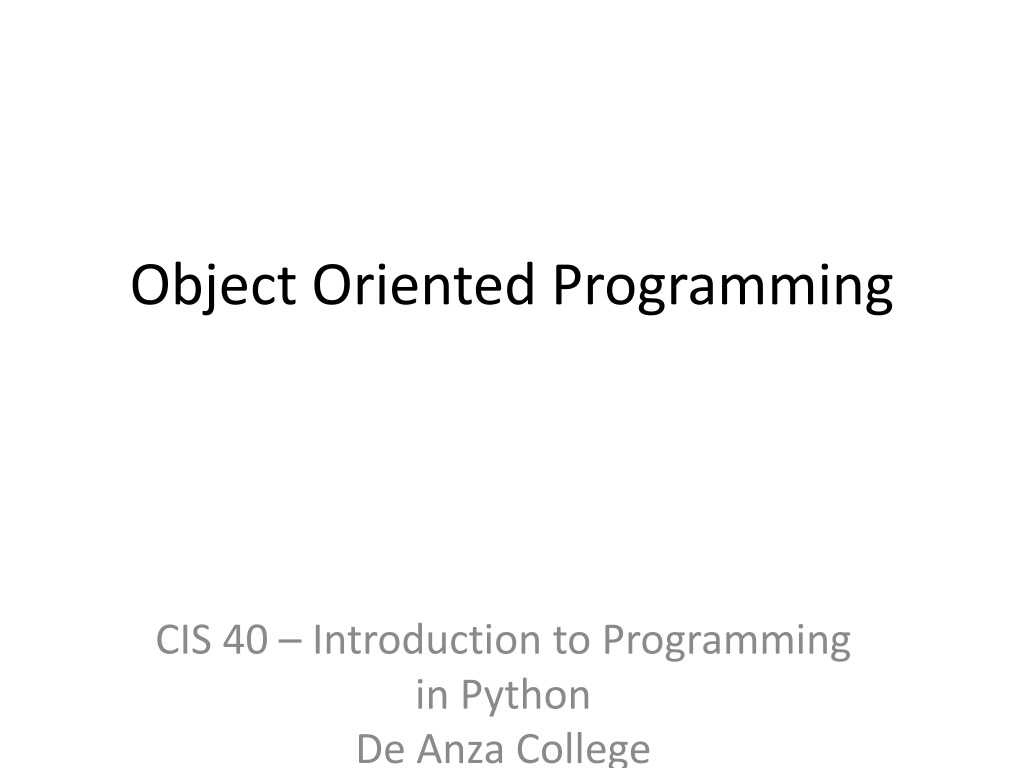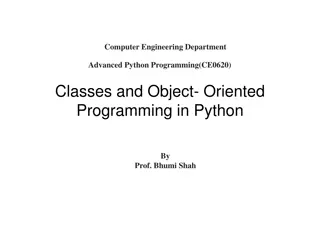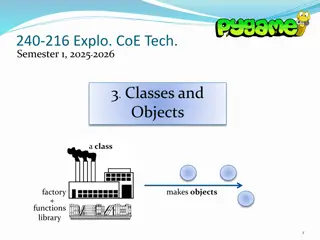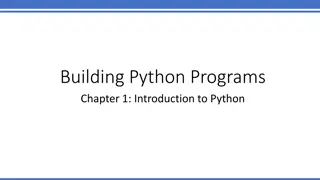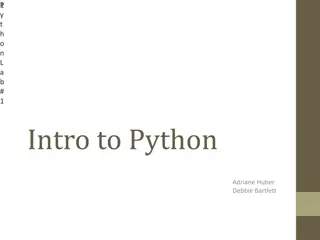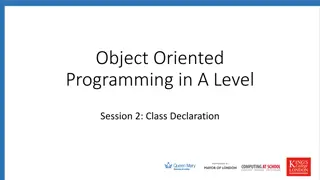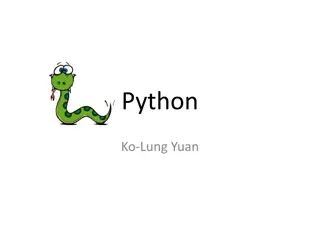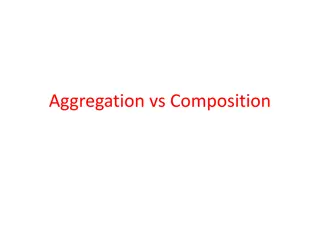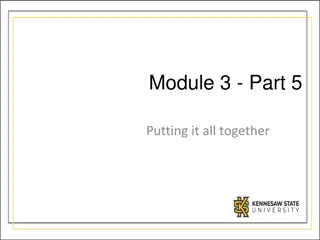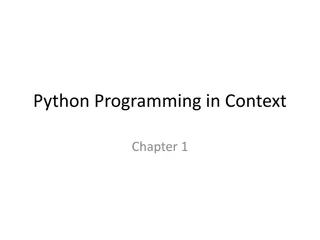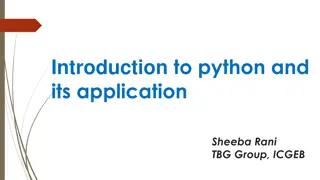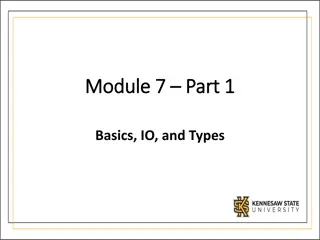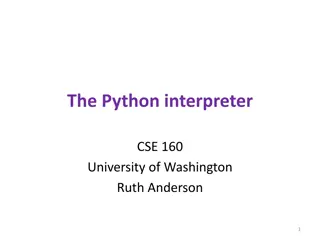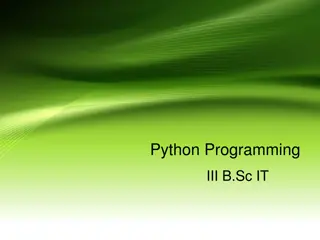Introduction to Object Oriented Programming in Python
In this module, we delve into the basic concepts of object-oriented programming in Python. We explore classes and their objects, using examples like lists and the Turtle module to understand how classes and objects function. Learn how to create specialized data types using the class concept in an object-oriented program.
Download Presentation

Please find below an Image/Link to download the presentation.
The content on the website is provided AS IS for your information and personal use only. It may not be sold, licensed, or shared on other websites without obtaining consent from the author.If you encounter any issues during the download, it is possible that the publisher has removed the file from their server.
You are allowed to download the files provided on this website for personal or commercial use, subject to the condition that they are used lawfully. All files are the property of their respective owners.
The content on the website is provided AS IS for your information and personal use only. It may not be sold, licensed, or shared on other websites without obtaining consent from the author.
E N D
Presentation Transcript
Object Oriented Programming CIS 40 Introduction to Programming in Python De Anza College
Intro In this module we explore the basic concepts of object oriented programming: classes and their objects. We will look at lists and the Turtle module as examples of classes in Python to get an understanding of how classes and objects work. Then we use the class concept to create our own specialized data type and use it in an object oriented program.
What Is a Class? A class is a data type that allows for data storage and a set of methods to access the data. Recall the diagram of a container or a list in the last module: Container Method Operator data data data Method Method data data data data When we use a list, we can store data in it and we can call methods such as append, sort to do work with the data. A container is a specific type of class, therefore the diagram of a class is the same as above, with data storage and methods. The Python built-in data types that we ve been using: int, str, list, etc. are each a specific type of class. In fact, every data type in Python is a class, and Python is called an object oriented language.
Advantage of Classes It is good to have class (both in real life and in programming). There are 2 main advantages to using classes: 1. Classes allow us to model real life entities, which makes the design of the software more intuitive. 2. Classes can be re-used, which makes software development faster because we can take advantage of existing classes. In the next slides we will go over each of the advantages in more detail.
Modeling with Classes (1 of 2) Advantage 1: Classes allow us to model real life entities, which makes the design of the software more intuitive. In real life, entities such as a school, a car, a basketball player, a dog, a movie all have specific behaviors. We expect a dog to bark and a basketball player to shoot hoops. Because a class allows for both data and the methods to access the data, the methods effectively control the behavior of a class. A list class has a method to sort data, but a set class does not have a sort method because data in a set are not in any particular order. By not having the sort method, we enforce the unordered data behavior of a set. When we create our own class, let s say BankAccount, we will have a withdraw() and a deposit() methods, because these are behavior of a bank account.
Modeling with Classes (2 of 2) Having data mimic or model real life entities makes it easier to design the software. If we want to write software for a bank, it is intuitive to think of a Bank class with methods such as set_interest_rate(), advertise(), maintain_website(), invest(), etc. The Bank class can contain other classes such as CheckingAccount class, SavingsAccount class, SafeDepositBox class, etc. And each of these classes will have its own methods or behavior. The design of the bank software becomes more natural when we have classes that model real life entities of a bank.
Class Re-Use (1 of 2) Advantage 2: Classes can be re-used, which makes software development faster because we can take advantage of existing classes. Some general purpose classes, such as the list class, can be useful in many situations. Someone wrote the list class, and the rest of us can use it without having to write the code for it. This makes our own coding effort shorter. Python supports class re-use by providing many software modules. Each module is a set of classes that do work in a specific area. For example, we ve used the Turtle module for graphics output, without having to write a single line of graphics code.
Class Re-Use (2 of 2) Python also encourages class re-use by supporting inheritance. Working with inheritance is beyond the scope of CIS 40, but it s good to have an overview of this important concept of object oriented programming or OOP. When an existing class is a general format of the class that we want to create, inheritance lets us re-use the existing class. Example: A Cat class is already written with cat-type methods or behavior. We want to create a Manx class to represent the Manx breed of cats. When we create the Manx class, the class inherits from the Cat class, which means that it automatically contains all the methods of the Cat class. We don t need to re-write the meow() method or the scratch() method. We only need to write the methods that are specialized to the Manx breed, such as the tail() tail = false method.
Classes and Objects (1 of 2) So far we know that a class: Allows for data storage and methods to access data, which specify the behavior of the class Provides 2 main advantages for software development The third part of a class definition is: A class is a data type. The BankAccount class is a data type, just like int is a data type. When we want to store the value 5 in our code, we need to store it in a memory space that has the data type int. Likewise, when we want to store bank account data in our code, we need to store it in a memory space that has the data type BankAccount. The memory space that has a class data type is called an object.
Classes and Objects (2 of 2) A class is a description of the data type and its behavior. An object is the actual memory space that stores data. An object is an instance of a class. From one class (or one description), many objects of that class can be created in memory to store data. Here are two common analogies to illustrate the relationship between a class and an object: A class is like an architect s blue print of a house, a design on paper. The house is the object, it is built from the design. Many house instances can be built from one blue print. A class is like a blank tax form provided by the IRS. When a person fills in the tax form to submit it, the completed form is an object. Many people can use the same tax form and fill it with their own data, creating many objects of the same tax form data type.
Defining a Class (1 of 3) We are not limited to using classes that are built-in to the Python language. We can create or define our own class. Format for defining a class: name in uppercase class ClassName: def __init__(self, other arguments): # method to initialize the object method to create objects method to print objects def__str__(self): # method to print the object def other_methods(self, other parameters): # any other methods for the class Note indentation Every method has self as the first parameter. self specifies the object, and every method works on the object.
Defining a Class (2 of 3) The __init__ method: def __init__(self, other arguments): # method to initialize the object The name starts and ends with 2 underscores ( _ ). When an object is instantiated or created, the __init__ method runs to initialize the object with data. The data can be a default value or it can be passed in through the arguments. The __str__ method: def__str__(self): # method to print the object The name starts and ends with 2 underscores. When the function print is used to print the object, the __str__ method runs to return a string of object data, which is printed to screen. The class typically has other methods to define its behavior.
Defining a Class (3 of 3) Example of a bank account class definition: We must pass in the account number and balance when creating the object The last 4 methods let us: Print the acct info as a string Get the acct number Get the acct balance Make a deposit Note that all object data variables start with: self.
Working With an Object (1 of 2) Before we instantiate or create an object from a class that we define, we must import the class. This is similar to how we import the Turtle class before we can use the turtle graphics. To instantiate an object: Type the class name, which runs the __init__ method of the class. If the __init__ method has input parameters other than self, provide data for them. The __init__ method returns the object, which needs to be assigned to a variable. To work with an object is similar to working with any of the Python objects: object_name.method_name(any parameters)
Working With an Object (2 of 2) Working with an example object of the BankAcct class: Code Cod Output
Congratulations! You have reached the end of your introductory journey into the programming world. Along the way you ve learned programming concepts such as data storage, instruction execution, IO, selection and loop constructs, functions, graphical output, and OOP. You ve also experienced a shortened software development cycle. That s quite a few topics that we ve covered. The experience may have had a few Duh! I can t believe I did that! but over all, hopefully you can see how programming can be a creative and rewarding activity, as the first module claimed.
